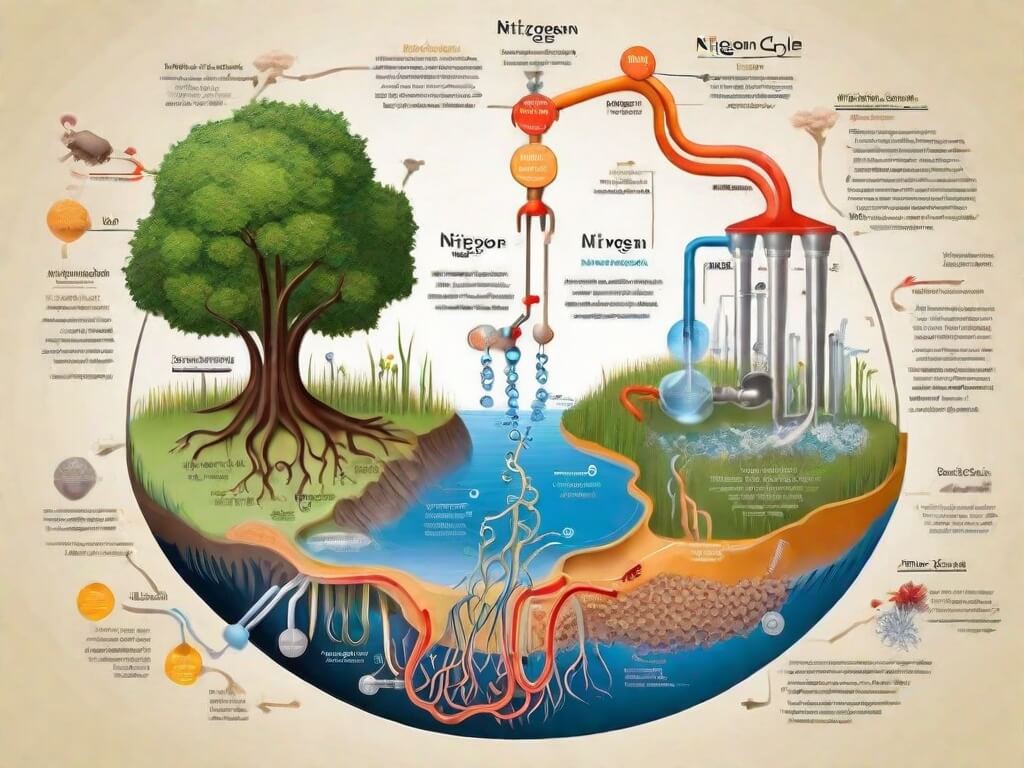What is Nitrogen cycle? DDive into the intricate world of the nitrogen cycle! Uncover the stages, significance, and environmental impact of this vital natural process. Explore the dynamics that sustain life on Earth. 🌱🔄

Nitrogen is an important element in living things. It is a basic component of aminoacids which form proteins.
78% of the air is nitrogen gas. Can we use the nitrogen in the air? No, plants, animals and people cannot use this nitrogen. So where do people get nitrogen from? Get nitrogen from the foods (protein).
Certain bacteria (nitrogen fıxing bacteria) in the soil change nitrogen gas into nitrogen compounds. Some of them are found free in the soiL. Others live in the root of legume plants (beans, peas, clover etc.) Plants take in the nitrogen compound through their roots in the soil. Plants use the nitrogen compounds to make proteins. When animals eat plants they take in the plant’s proteins. Then they use it to make new proteins. How does nitrogen gas return to the air?
When dead plants, animals and waste are decomposed, simple nitrogen compounds (ammonia) are produced. Plants take in these compounds from the soil. Some of the compounds are also changed by certain bacteria into nitrogen gas, which goes into the air.
There are several effects that change the balance of the nitrogen cycle in nature. The most important one of these is the growing needs of agriculture have led to increase the production of industrially fixed nitrogen. 1/3 of all the nitrogen fixation occuring taday artifically. Most of the industrially fixed nitrogen is used as fertilizer. Second one is the widespread cultivation on of legume plants (alfa, alfa, soybeans, clover). The bacteria in their roots use more atmospheric nitrogen and it raises the nitrate content of the soil. It is best for other plants.
The effects of fertilizers on the ecosystem
Fertilizers play a crucial role in modern agriculture by enhancing soil fertility and promoting plant growth. However, their widespread use has raised concerns about their impact on the ecosystem. In this discussion, we will delve into the effects of fertilizers on the ecosystem, considering both the positive and negative aspects.
Positive Effects: Fertilizers contribute to increased agricultural productivity, ensuring higher crop yields to meet the demands of a growing population. By supplying essential nutrients like nitrogen, phosphorus, and potassium, they enhance soil fertility, supporting plant growth and development. This aspect is vital for global food security and the economic sustainability of the agricultural sector.
Negative Effects:
- Water Pollution:
- One significant drawback of fertilizers is their potential to leach into water bodies. Excess nutrients, particularly nitrogen and phosphorus, can contaminate rivers, lakes, and groundwater. This nutrient runoff contributes to algal blooms, disrupting aquatic ecosystems and causing oxygen depletion, leading to “dead zones.”
- Soil Degradation:
- Overreliance on fertilizers can alter the soil’s natural composition and structure. Continuous use may lead to soil acidification, nutrient imbalances, and reduced microbial diversity. This degradation can compromise the long-term fertility and resilience of the soil.
- Impact on Biodiversity:
- The alteration of nutrient levels in the soil can favor certain plant species over others, affecting the diversity of plant communities. This, in turn, can impact herbivores and other organisms dependent on specific plant species, potentially leading to shifts in biodiversity.
- Greenhouse Gas Emissions:
- Certain fertilizers release nitrous oxide, a potent greenhouse gas, into the atmosphere. Nitrous oxide contributes to climate change and ozone layer depletion, emphasizing the indirect environmental consequences associated with fertilizer use.
Conclusion: While fertilizers play a vital role in ensuring food security, it is crucial to manage their use judiciously to mitigate their negative impacts on the ecosystem. Sustainable agricultural practices, precision farming, and technological innovations can help strike a balance between meeting agricultural demands and preserving the health of our ecosystems.